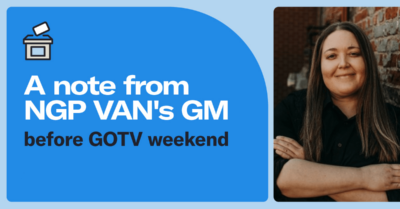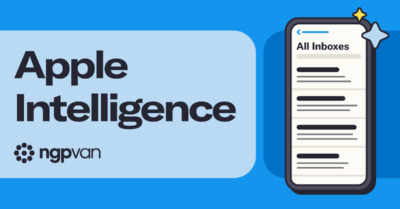Political persuasion: Creating and engaging your audiences

To win an election or advance a political cause, you need thoughtful strategies for convincing and mobilizing voters. One strategy that’s a key part of any campaign plan is political persuasion — the act of convincing unlikely voters to support your campaign or cause.
Political persuasion requires effective communication and voter targeting to be executed well. That’s why we’ve compiled the best tips from our webinar on engaging political persuasion audiences in this guide. We’ll define political persuasion, which voters to target, and how to use the most effective political persuasion techniques to help your candidate win.
Watch the full webinar below to learn about creating and engaging political persuasion audiences!
What is political persuasion?
Political persuasion is the art of convincing voters to support your campaign. It’s a valuable tactic for many campaigns and causes that may not be able to win their race without convincing unlikely and unaware voters to support their efforts.
For instance, you need to create a persuasion universe (a list of target voters to persuade) if there aren’t enough likely supporters to hit your win number or if you want to expand your margin of victory in the upcoming election. Political persuasion is particularly effective for a few groups of voters that you can easily target with a voter database, which we’ll cover later. But first, let’s break down the differences between persuasion and mobilization.
Political persuasion vs. mobilization
Persuasion and mobilization are both key efforts for most races, but they require very different tactics that target distinct groups of voters. The basic differences can be summed up like this:
- Political persuasion focuses on convincing unlikely voters to support your campaign. It requires more planning and message development, more “touches” (contacts) with voters, and savvier communicators aimed at different audiences within your persuasion universe. For instance, messaging that works well with voters who don’t know you may not work well with voters of different political parties.
- Political mobilization focuses on getting identified and likely supporters out to vote. Mobilization involves volunteers providing information, resources, and encouragement to those likely to support your campaign if they vote. These efforts are also called Get Out the Vote (GOTV).
Some campaigns or causes may only execute mobilization efforts because they have a comfortable margin of identified and likely supporters, but that’s not the case everywhere. Even if you do have enough likely voters to reach your vote goal, you should plan to engage your persuasion universe anyway if you have the time and resources to do so.
How to develop a political persuasion strategy
With those differences in mind, we’ll explore how to run a campaign with a focused political persuasion strategy, beginning with your persuasion universe.
1. Define your persuasion universe
Your persuasion universe includes all the voters you plan to contact about supporting your campaign or cause who are not as likely to do so.
Several voter audiences may be potential targets for your persuasion universe, including:
People who don’t know about your campaign
These voters may not know who your candidate is, but they may support your campaign once they learn more about it and where your candidate stands on pressing issues. This group may include Democratic and progressive voters who don’t keep up with local politics, aren’t aware that there’s an election, or just haven’t heard of your campaign yet.
Members of other parties
While members of other parties are unlikely to support your campaign or cause in general, many can be persuaded with the right push. Some may be upset with the direction of their political party, the candidate who is running on their party’s ticket, or another factor that presents an opportunity to convince them to support your campaign or cause (or at least not vote for your opponent).
Those not likely to support your campaign
While some may fall into one of the above groups, these people are especially unlikely to support your campaign or cause due to a stance on a particular issue or some other factor. These voters are more difficult to target, but they can still be a valuable persuasion audience to engage with.
To target each of these groups effectively and convince them to support your campaign or cause, you need to serve them different, catered messages. Think about the motivations, values, and priorities of those in each group, and craft messages that speak to these factors specifically.
2. Create and populate your persuasion universe
Now that you know what kind of voters should make up your persuasion universe, it’s time to identify exactly who those voters are.
First, determine how many voters you must convince to win your race. Once you have your win number, you can build your persuasion universe to meet or exceed that number. To do so, you’ll need voter data and a way to organize voter targets within a database.
You can easily create and populate a persuasion universe within SmartVAN by following these steps:
- Create a new list within your database
- Search for all registered voters in your district
- Narrow down your audience using relevant tools like TargetSmart Ideology and Non-Partisan Voter Turnout (this will help you zero in on the groups we discussed)
- Use the “Add a Step” button to remove all registered Democrats from the list
This will present you with an initial list of target voters for your persuasion universe. If this list is too large, narrow it further based on voting history. You might search for all the voters on your list who previously voted in a Democratic primary, for example, indicating that they may be more open to political persuasion.
3. Plan how you’ll use political persuasion channels
After creating your persuasion universe, prepare to contact the voters on your list by dividing them into groups based on which channel you’ll use to contact them.
The best channels for political persuasion are those through which you can have one-on-one conversations with voters — either in person or over the phone. This means relying on the following two channels:
Canvassing
Door-to-door canvassing is one of the most effective channels to employ political persuasion. With our mobile canvassing app, MiniVAN, your campaign or cause can easily guide volunteers’ conversations with voters, record valuable data, and sync it instantly back to VAN to act on later in the campaign.
Phone banking
Phone banking is more effective for contacting voters in your persuasion universe who you can’t easily connect with in person. With a tool like OpenVPB, you can even create phone banks that map different scripts to different people and allow callers to toggle between scripts.
To create your field plan for political persuasion, determine which groups of voters are ideal for canvassing or phone banking based on their geographic spread. For example, you may want to canvass in areas of higher voter density (i.e., many voters in your persuasion universe who live close together) and make calls in areas where voters are more spread out. For both methods, you’ll need a persuasion script and several volunteers.
4. Develop a script
Successful political persuasion requires detailed scripts that address all the kinds of responses your volunteers may get. This includes:
- Strong support: Someone who was successfully persuaded and verbally expresses support for your candidate or cause
- Lean support: A voter who indicates that they may vote for your candidate
- Undecided: Voters who don’t give you a clear indication of their opinion or intent to vote one way or the other
- Lean opponent: Someone who’s leaning toward voting for your opponent but may still be open to persuasion
- Strong opponent: Voters who are certain they will not support your candidate or cause and want to end the conversation
For those in the middle range (lean support, undecided, and lean opponent), prepare word-for-word responses. Validate voters’ opinions, but provide additional information that may sway them further in your candidate or cause’s direction. This might be data from your candidate’s voting history or a specific comparison to the competition. No matter what, thank everyone you talk to, even if they give a strong no.
To help your volunteers navigate all potential responses, MiniVAN enables you to create branched scripts that offer different questions and prompts based on a voter’s answers. You can choose a default script and up to four alternates to give your canvassers up to five scripts to employ, or you can choose a default script and alternate scripts based on a target’s subgroup.
5. Recruit the right volunteers
Political persuasion requires savvy communicators who can adapt and address issues that this audience may raise. It’s important to understand who your most capable volunteers are so you can train them for these situations.
Specifically, the volunteers you choose for these efforts should be:
- Trusted by your campaign team or organization
- Able to communicate respectfully with those who have different opinions than their own
- Committed to sticking to your political persuasion script
- Able to judge when conversations are promising and when they may not be worth the time needed to convince them
If you’re unsure who these volunteers are, talk with your field organizer or volunteer manager to get their opinion. You can also provide quick training sessions at the start of phone banks and canvassing days to better prepare any volunteers you have for political persuasion.
Key political persuasion techniques
Use these techniques and strategies to persuade more voters and push your candidate closer to victory.
Use a smart voter database to filter your audience
Political persuasion is all about targeting the right voters. With a smart, comprehensive database like VAN, you can easily identify the best target voters for your persuasion universe. VAN makes it easy to create your persuasion universe through several scores and other targeting parameters. You can use ideology or support scores and past voting history to zero in on the group of voters that will be critical to your campaign or organization’s success.
For instance, you can create a Supporter ID Survey Question with responses from one to five, with one indicating strong support for your campaign or cause and five indicating strong opposition to your campaign or cause. Then, use these scores to prioritize voters in your persuasion universe more effectively and efficiently.
Prepare to talk about the opposition
Opposition research isn’t just important for campaign planning and message development — it’s also a highly useful tool for political persuasion. Research your candidate or cause’s opponents thoroughly, noting any of their past legislative decisions or personal values that may not align with everyone in their party. Incorporate any useful information into your persuasion scripts to improve them.
Explore other persuasion methods like endorsements
While one-on-one conversations allow campaigns and causes to address key issues with your persuasion universe, other broader contact methods may play a role in convincing voters to support your campaign or cause.
For instance, some voters may value endorsements from elected officials or advocacy groups, digital ads that communicate why your candidate is better for the job, or something else to determine how they’ll vote in an upcoming election. Use all of these to your advantage, and consider highlighting your campaign’s endorsements in your persuasion scripts if relevant.
Persuade people to vote for your campaign with NGP VAN
Through voter targeting in VAN and effective voter outreach through tools like MiniVAN and OpenVPB, you can easily and effectively engage with your persuasion audience to help you achieve your goals. Get started with NGP VAN today to set your campaign up for success.



